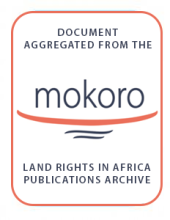Land Library Search
Through our robust search engine, you can search for any item of the over 73,000 highly curated resources in the Land Library.
If you would like to find an overview of what is possible, feel free to peruse the Search Guide.
/ library resources
Showing items 1 through 9 of 239.The final part of a blog series is a very preliminary reflection on the changes observed over 20 years and some speculation on what the future might hold for the land reform farmers of Masvingo over the next 20 years.
A paper from the Agricultural Policy Research on Africa (APRA) programme in Zimbabwe supported by a DFID grant to IDS;Sussex.
This working paper presents the results of a study commissioned by the International Centre for
Tropical Agriculture (CIAT) under the Grass2Cash project whose primary objective was to understand
Humanity depends on the existence of healthy soils, both for the production of food and for ensuring a healthy, biodiverse environment, among other functions.
Many development countries are currently undergoing major demographic shifts as the percentage of young people of the total population rapidly increases. This shift is associated with high rates of migration, unemployment and instability.
The productivity of small ruminants in developing countries remains low although the animals play an integral role in the livelihoods of smallholder farmers.
Uganda submitted its first Nationally Determined Contribution (NDC) in 2015 to the UNFCCC through which it committed to reduce approximately 22% of national GHG emissions in 2030 compared to business-as-usual of 49 million MtCO2eq.
"Climate adaptation has been on the back seat of the international policy agenda for many years; the Paris Agreement and relating Global Goal on Adaptation (GGA) provide new momentum to frame adaptation as a global responsibility and to call for collective measurement approaches.
As part of the project “Developing Gender
Indicators in Agriculture,†we conducted a literature
review in order to understand how research and
agricultural development projects in Latin America
measure women’s empowerment and gender


